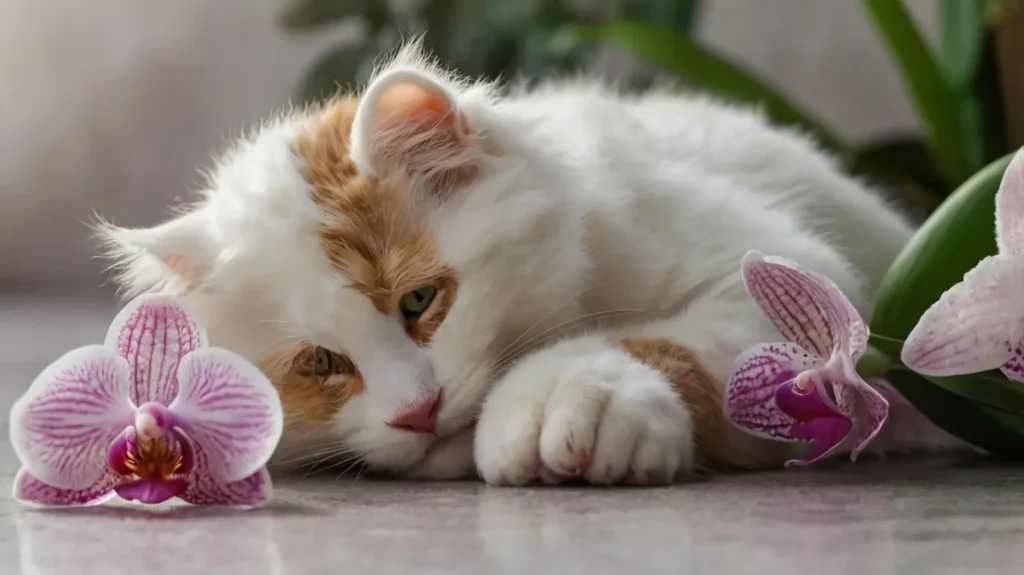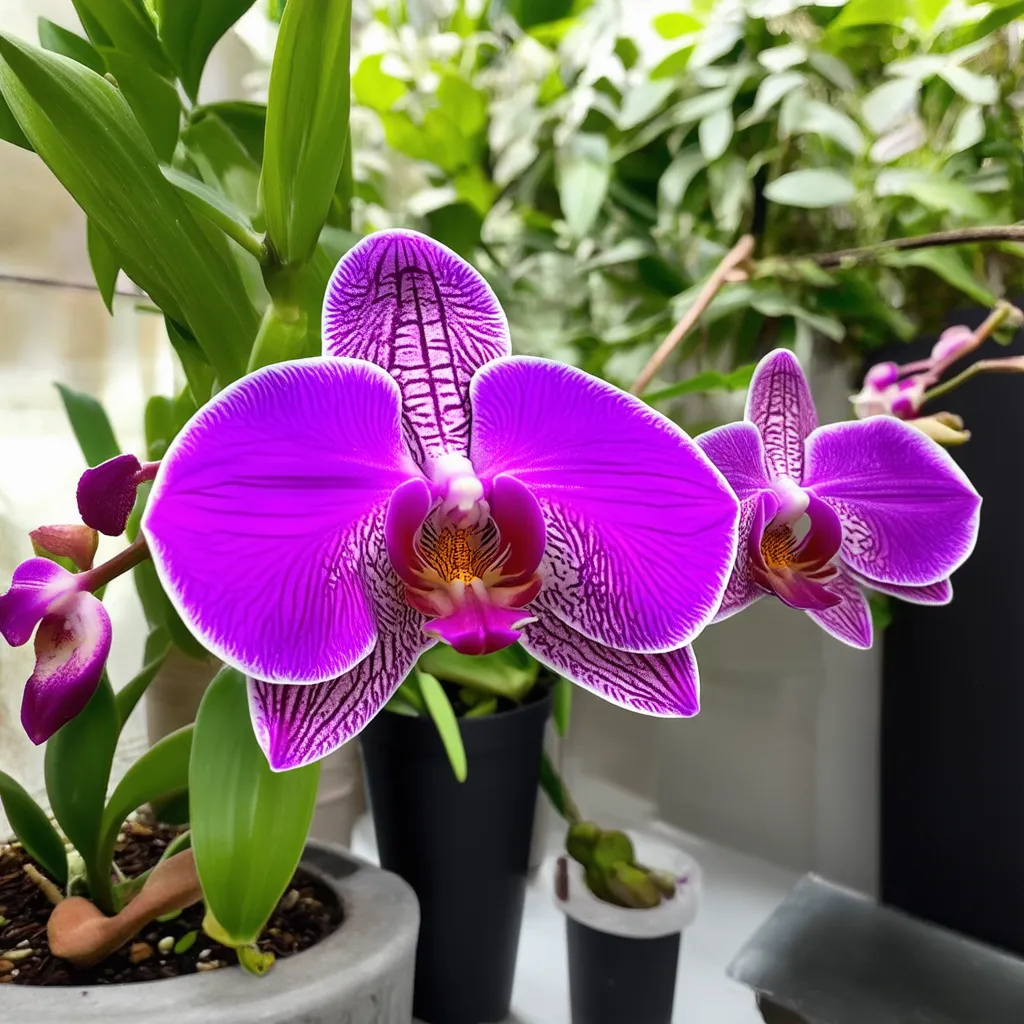Are Orchids Safe for Cats? A Complete Guide to Pet-Friendly Plants

If you’re a pet owner, you love your cats and want to keep them safe at home. Decorating with plants is popular, and orchids are a favorite. But, are orchids safe for cats? This guide will explore orchid toxicity and help you pick pet-friendly plants for your home.
Table of Contents
Key Takeaways
- Orchids are generally considered safe for cats, with only a few species posing potential risks.
- Understanding the basic anatomy of orchids and common cat behaviors can help pet owners make informed decisions.
- Identifying signs of plant-related issues in cats and promptly seeking veterinary care are crucial for their well-being.
- Incorporating strategies to create a cat-safe environment with orchids can ensure your furry friend’s safety.
- Regular monitoring and proactive steps can help you enjoy the beauty of orchids without compromising your cat’s health.
Understanding Orchid Safety: Are Orchids Safe for Cats?

As a cat owner, you might wonder if orchids are safe for your pet. The good news is that many orchids are safe for cats. Knowing which orchids are safe and how cats interact with plants can help you decide.
Common Orchid Species in Households
Popular orchids like Phalaenopsis, Dendrobium, Oncidium, and Cattleya are generally safe for cats. These orchids don’t have toxic compounds that could harm your cat. But, always check the orchid type before bringing it home to make sure it’s safe.
Basic Orchid Plant Anatomy
Orchids have roots, stems, leaves, and flowers. Most of these parts are safe for cats, but the stems and roots might cause irritation if eaten. Good care and keeping your cat away from the plant can prevent problems.
Natural Cat Behavior Around Plants
Cats are curious and might chew on plants. While orchids are usually safe, watch your cat around them. If your cat seems sick after touching an orchid, see a vet right away.
| Orchid Species | Toxicity Level for Cats |
|---|---|
| Phalaenopsis (Moth Orchid) | Low Toxicity |
| Dendrobium | Low Toxicity |
| Oncidium | Low Toxicity |
| Cattleya | Low Toxicity |
The Truth About Orchid Toxicity Levels
Many people think all orchids are dangerous for cats. But, not all orchids are harmful. The danger level varies by species.
Orchids come from the Orchidaceae family, with over 25,000 types. Some orchids have mildly toxic parts, but the danger level can vary. Knowing about orchid toxicity helps keep homes safe for cats.
| Orchid Species | Toxicity Level for Cats |
|---|---|
| Phalaenopsis (Moth Orchid) | Low Toxicity |
| Dendrobium | Moderate Toxicity |
| Cymbidium | Low Toxicity |
| Oncidium | Moderate Toxicity |
Vets say common house orchids like Phalaenopsis and Cymbidium are mostly safe for cats. They might cause a bit of stomach upset if eaten. But, they’re not dangerous.
However, some orchids like Dendrobium and Oncidium are more toxic. Eating these can make cats very sick. They might vomit, have diarrhea, or even get neurological problems. Owners should be careful with these types.
“It’s important to remember that even low-toxicity orchids can pose a risk to curious cats. Proper precautions should always be taken to ensure the safety of our furry friends.”
Knowing about orchid cat toxicity helps cat owners choose safe plants. Being responsible and doing research can make homes safe for both plants and pets.
Signs and Symptoms of Plant-Related Issues in Cats
We all love our cats, but we must watch out for dangers from plants. Knowing the signs of plant problems can help you act fast. This way, you can keep your cat safe and healthy.
Physical Symptoms to Watch For
Look out for these signs if your cat has been near orchid plants:
- Drooling or excessive salivation
- Nausea and vomiting
- Lethargy or weakness
- Skin irritation or rashes
- Difficulty breathing or respiratory distress
Behavioral Changes After Plant Contact
Changes in behavior can also signal plant problems. Watch for these signs:
- Increased pawing or licking at the mouth or face
- Reluctance to eat or drink
- Disorientation or confusion
- Unusually aggressive or irritable demeanor
When to Contact Your Veterinarian
If you see any of these signs, call your vet right away. Quick action can prevent bigger problems. Always prioritize your cat’s safety around orchid plants and cats.
Creating a Cat-Safe Environment with Orchids
As an orchid lover with a cat, you can make a safe and beautiful home. It’s all about where you put your orchids and how you take care of them. This way, you can enjoy your plants and keep your cat safe.
Start by placing your orchids where your cat can’t reach them. Put them on high shelves or in rooms your cat doesn’t go into. You can also use things like sticky tape or citrus sprays to keep your cat away.
If you want your orchids where your cat can see them, think about using safe plants instead. Catnip, cat grass, or spider plants are good choices. They’re safe for your cat and add beauty to your home.
FAQ
Are orchids safe for cats?
Many pet owners worry about orchids and their cats. Some orchids can be harmful, but not all. Knowing which orchids you have is key to keeping your cat safe.
What are the common orchid species found in households?
Homes often have Phalaenopsis (moth orchids), Dendrobium, Cymbidium, and Oncidium orchids. Each type has its own look and risks for cats.
How do cats typically behave around plants?
Cats love to explore and may play with plants. This can be risky if the plant is harmful to them.
What is the level of orchid toxicity for cats?
Orchids are not very toxic to cats. Eating parts of the plant might upset their stomach a bit. But most orchids are not very poisonous.
What are the signs and symptoms of plant-related issues in cats?
Cats might vomit, drool, or act tired if they touch orchids. They could also eat less or seem upset. If you see these signs, call your vet.
How can I create a cat-safe environment with orchids?
To keep your cat and orchids safe, put plants out of reach. Use high shelves or closed terrariums. You can also use citrus or sticky tape to keep cats away. Choosing safe orchids is also a good idea.
